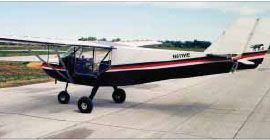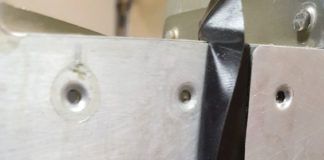In the past few months, we have been exploring the lateral and directional stability and control of airplanes. This month, we turn our attention to a lateral/directional issue that is specific to multi-engine airplanes: maintaining control with one or more engines inoperative. One engine inoperative (OEI) operations are an important factor in the design of multi-engine airplanes. Not only must the airplane have sufficient performance to safely maintain flight after an engine failure, the pilot must also be able to maintain control.
There is an old pilots joke that says that the function of the second engine on a light twin after an engine failure is to carry the airplane to the scene of the accident. This morbid assessment is a bit of an exaggeration, but it does point out that while having two engines gives one a chance of flying away from an engine failure, single-engine flight in a twin is not easy and requires significant pilot skill (and training) to be safe.
For a conventional twin with wing-mounted engines, the critical parameter is the engine-out minimum control speed (Vmc). This is the minimum airspeed at which full rudder will keep the airplane from yawing with one engine inoperative and full power on the live engine. Vmc is critical in low-airspeed situations where the good engine is called upon to produce maximum power. Typically these are the initial climb after takeoff and a missed approach with an engine out. A common light-twin accident sequence is an engine failure shortly after takeoff, followed by loss of control when the pilot allows the airspeed to fall below Vmc while attempting to continue to climb.
The thrust of a wing-mounted engine produces a yawing moment on the airplane. The engine pulls forward on the wing, causing the airplane to yaw away from the engine. When both engines are operating, the yawing moment of the left engine cancels the yawing moment of the right engine.
When one engine fails, several things happen. First, the thrust of the dead engine disappears along with the yawing moment it produces; the airplane experiences a net yawing moment toward the dead engine. Two other factors can worsen this effect. The first is the drag of the propeller on the dead engine (or the windmilling drag of an inoperative jet engine). Immediately after the engine failure, the blades of the propeller produce significant drag because the airflow is hitting them from the front and separating behind them. If the propeller is windmilling, it can also produce a lot of drag as the blades lift backward and the propeller tries to drive the dead engine. Until the propeller is stopped and feathered, the drag of the dead prop reduces the ability of the airplane to maintain airspeed or to climb. This also drags the dead-engine wing backward, increasing the yawing moment toward the dead engine.
When the engine stops running, the propeller stops accelerating air aft, and the slipstream behind the propeller disappears. The effective airspeed of the portion of the wing that was in the slipstream decreases, causing a loss of lift. This may be exacerbated by separated or disturbed airflow coming off of the propeller blades if the prop is not feathered. The loss of lift will cause the airplane to roll toward the dead engine. This roll will be accelerated by the natural dihedral effect of the airplane if the pilot fails to keep the airplane from yawing.
The yawing moment produced by the live engine is a function of the thrust of the engine. The counteracting yawing moment produced by the rudder is a function of rudder deflection and airspeed. As airspeed decreases, the yawing moment produced by a given rudder deflection decreases, but the thrust of the engine does not decrease with airspeed. At some speed, the yawing moment produced by the rudder at full deflection will just balance the yawing moment produced by the thrust of the live engine. This airspeed is the Vmc. If the airspeed gets below this critical speed, the airplane will yaw toward the dead engine in spite of full opposite rudder.
A pilot of a twin that suffers an engine failure right after takeoff is faced with a rapidly deteriorating situation. Thrust has been cut in half, and drag has increased. Without prompt action to lower the nose and establish a shallower flight path, airspeed will continue to decay.
At the same time, the airplane has developed a large yawing moment and some rolling moment toward the dead engine. In addition to dealing with decaying airspeed, the pilot must keep the airplane straight with the rudder.
The pilot must keep the airplane under control laterally, keep the airspeed from decaying below Vmc and, at the same time, identify and secure the dead engine, feather the prop on that engine and clean up the airplane to maximize the (usually sluggish) single-engine rate of climb. Failure to complete even one of these tasks properly and quickly can lead to an accident.
For a pilot, proficiency is the best defense against this type of accident. But manufacturers can also help pilots by designing twins to have safer engine-out characteristics. The single most important thing the designer of a twin can do to increase safety is to get Vmc down. Ideally, it should be below stall speed, but on many airplanes it is not. On some twins, it is actually above the twin-engine best angle of climb speed. This is particularly dangerous because it tempts the pilot to deliberately climb at an airspeed below Vmc to use the best twin-engine climb performance of the airplane. This will typically happen during a maximum effort short-field takeoff. If an engine fails while the airplane is climbing below Vmc the only option the pilot has is to drop the nose and reduce power on the live engine quickly to prevent loss of control. Design factors will affect how a multi-engine airplane performs when an engine is lost.
Engine Placement
The distance between the engines and the centerline of the airplane is one of the most powerful determinants of minimum control speed. The yawing moment produced by the operating engine is the product of the engine thrust multiplied by the lateral distance between the engine thrust line and the center of gravity of the airplane. The further outboard the engines, the greater the yawing moment caused by each engine. To minimize Vmc the engines should be as far inboard as is practical.
While Vmc considerations tend to force the engines inboard, there are several other factors pushing them outboard, and the designer must consider all of these. The most important factor is clearance between the propeller and the fuselage. Obviously, a propeller blade tip striking the fuselage would be a bad thing. Engines are typically mounted on soft, vibration-absorbing rubber mounts, which allow the engine to move around a surprising amount. The static clearance between the propeller blade tips and the side of the fuselage should be large enough so that engine motion cannot bring the blades into contact with the fuselage.
Noise and vibration inside the cabin are also a consideration. The majority of the noise emitted by a propeller radiates from the blade tips in or near the plane of the prop. If the clearance between the blade tips and the fuselage side is too small, the noise and vibration level in the cabin will be high.
Having the engines too far inboard on the airplane can also increase drag. If the propeller slipstream scrubs along the fuselage side, it will increase skin friction drag. Also, the channel flow between the fuselage and engine nacelle can cause significant drag.
Finally, moving the engines outboard can reduce the weight of the wing structure. The weight of the engine acting on the wing produces a moment that opposes the upward bending of the wing. The further outboard the engine, the greater this bending moment relief. The wing weight advantage gained by moving the engines outboard will be partially offset by the need to increase the size of the fin and rudder to oppose the increase yawing moment produced by the engine.
The designer must balance all of these considerations when choosing the lateral position of the engines. Usually, the tip clearance and acoustic considerations set the minimum acceptable distance between the prop tips and the cabin wall, and this determines the engine position. The load relief provided by moving the engines outboard on a twin is rarely worth the Vmc penalty it causes.
There have been a few attempts to improve engine-out characteristics by moving the engines very close together. These concepts all shared a few aspects. First, the position of the engines and the design of the fuselage (or fuselages) are chosen so that the propeller disks clear the fuselage by being in front of it or over it. The engines can then be moved inboard until the clearance between the propellers tips is at a minimum.
One of the more bizarre experiments along this line involved making a Siamese twin out of two Piper Tri-Pacers joined by a short stub wing. On this machine, the prop disks actually overlapped. A prop-shaft spacer was used to move one prop forward of the other. More recently, a twin-engine pusher ultralight with overlapping propellers has appeared.
Overlapping the propeller disks introduces various unpleasant aerodynamic interactions between the propellers and is probably not a good idea. However, moving the propellers inboard until the propeller tips just clear each other does work quite well as long as the rest of the configuration is well designed. Two modern examples of this approach are Burt Rutans Boomerang, which has the engines mounted in the noses of twin fuselages, and the AirCam, which has pusher engines mounted close together on a parasol wing. I have had the pleasure of a brief demonstration flight in the AirCam, and it is quite easy to control even with one engine out. This performance is all the more remarkable because the propellers are fixed pitch, so the dead-engine prop cannot be feathered.
Fin and Rudder
The yawing moment produced by the live engine is opposed by the aerodynamic moment produced by the fin and rudder. The total aerodynamic yaw control power available is a function of the fin area, the tail arm, the area of the rudder and the available rudder deflection.
The bigger the fin and rudder, the more yawing moment they can generate. Twins typically have vertical tails that are proportionately larger than singles to handle engine-out situations.
The side force produced by the deflected rudder acts on the aft end of the fuselage. The yawing moment is the product of this side force multiplied by the tail arm. Increasing tail arm increases the yaw power of a given fin and rudder.
Once the lateral position of the engines has been set, the size of the vertical tail and the length of the tail arm are the primary parameters the designer can use to affect minimum control speed.
The maximum deflection of the rudder also has an effect. Up to a point, increasing rudder deflection increases the side force generated by the fin and the rudder. The increase is linear with deflection up to a deflection of about 30. At higher deflections, the flow over the rudder starts to separate at the hinge line, and increasing deflection beyond this point will increase drag without producing a useful increase in rudder power. A row of vortex generators mounted just upstream of the rudder hinge line can help this situation. The vortex generators re-energize the boundary layer and delay separation. This increases the side force generated by the deflected rudder, and lets the rudder go to higher deflections without stalling. Vortex generators on the fin are a feature of several popular retrofit kits designed to improve the engine-out characteristics of twin-engine airplane.
Another trick that was popular at one time is to use a twin-tail configuration with two fins mounted at the tips of the horizontal tail. The advantage of this configuration for engine-out flight is that the fins are in the propeller slipstreams, while a single centerline fin is not. In the event of an engine failure, the fin and rudder behind the live engine have a higher effective airspeed due to the prop wash, increasing rudder power. The disadvantage is that in normal flight, both fins are in the prop wash, which increases drag. The twin-tail configuration was popular for a while, appearing on most Lockheed twins, the Beech 18 and the four-engine B-24 Liberator. In recent times, designers have returned to the single centerline fin in the interest of simplicity.
Barnaby Wainfan is a principal aerodynamics engineer for Northrop Grummans Advanced Design organization. A private pilot with single engine and glider ratings, Barnaby has been involved in the design of unconventional airplanes including canards, joined wings, flying wings and some too strange to fall into any known category.













